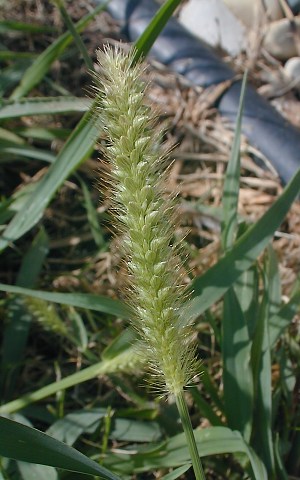Description:
This
grass is a summer annual about 1-3' long that usually
branches at the base, sending up multiple culms with alternate leaves.
These culms are ascending to erect, light green, hairless, and terete.
The leaf blades are up to 8" long and ½" across; they are
green to
greyish blue and flat, indented,
or slightly twisted. Each leaf blade is widest at the base, where there
may be a few long white hairs, otherwise it is hairless. The leaf sheaths are green to greyish blue, somewhat flattened, and hairless.
The culm terminates in a spike-like raceme of florets up to 5" long.
This inflorescence is densely covered with bristly spikelets throughout
its length. Each spikelet is ovoid and about 3 mm. long, consisting of
2 glumes, 2 lemmas, and a floret; the glumes are shorter than the
lemmas. At the base of each spikelet, there is a very short pedicel and
5-15 bristles up to 9 mm. long. Immature spikelets are shiny green,
while their bristles are yellow. During the blooming period, which
occurs from mid-summer to early fall, the spikelets are still green,
but their bristles become tawny-colored. With the maturity, the entire
inflorescence become light tan. The medium-large grains are ovoid and
somewhat flattened. The root system is fibrous. This grass spreads by
reseeding itself.
sheaths are green to greyish blue, somewhat flattened, and hairless.
The culm terminates in a spike-like raceme of florets up to 5" long.
This inflorescence is densely covered with bristly spikelets throughout
its length. Each spikelet is ovoid and about 3 mm. long, consisting of
2 glumes, 2 lemmas, and a floret; the glumes are shorter than the
lemmas. At the base of each spikelet, there is a very short pedicel and
5-15 bristles up to 9 mm. long. Immature spikelets are shiny green,
while their bristles are yellow. During the blooming period, which
occurs from mid-summer to early fall, the spikelets are still green,
but their bristles become tawny-colored. With the maturity, the entire
inflorescence become light tan. The medium-large grains are ovoid and
somewhat flattened. The root system is fibrous. This grass spreads by
reseeding itself.
Cultivation:
This adaptable grass is typically found in full sun, moist to slightly
dry conditions, and soil containing loam, clay loam, or gravelly
material. Most growth and development occurs during the summer. It
tolerates occasional mowing, although the surviving plants will be
shorter and less erect. This grass can spread aggressively in disturbed
areas.
Range & Habitat:
Yellow Foxtail is a common grass that occurs in every county of
Illinois (see Distribution
Map). It was introduced accidentally into North America from
Europe. Habitats
include limestone glades, gravelly areas along rivers, vacant lots,
lawns, grassy areas along railroads and roadsides, fields, pastures,
mined land, and miscellaneous waste areas. This grass prefers highly
disturbed areas and rarely invades natural areas to any significant
degree.
Faunal Relations:
The species Hysteroneura setaria (Rusty Plum Aphid)
was first discovered on Yellow Foxtail in Illinois. These aphids were
sucking plant juices near the seedheads. Other insects that feed on this grass include flea beetles (Chaetocnema spp.), Diabrotica barberi (Northern Corn Rootworm), Sphenophorus aequalis (Clay-colored Billbug), larvae of leaf-miner flies (Cerodontha spp.), seed-eating larvae of Contarinia sorghicola (Sorghum Midge), Oebalus pugnax (Rice Stink Bug), Melanoplus confusus (Little Pasture Grasshopper), Orphulella speciosa (Slant-faced Pasture Grasshopper), spikelet-eating meadow katydids (Conocephalus spp.), and the seed-eating Neoconocephalus ensiger (Sword-bearing Conehead). The foliage of Setaria
spp. (Foxtail grasses) is eaten occasionally by various
mammalian
herbivores, including livestock, rabbits, and voles. However, the
bristly seedheads of mature plants can damage the mouthparts of horses
and cattle. The seeds are eaten by the Thirteen-Lined Ground Squirrel
and many kinds of birds. As a matter of fact, the seeds of weedy
Foxtail grasses are among the most important sources of food to upland
gamebirds and granivorous songbirds (see Bird
Table for a listing of these species).
Photographic Location:
Edge of a lawn in Urbana, Illinois.

Comments: Yellow Foxtail (Setaria pumila) is one of the common and weedy Setaria spp. (Foxtail grasses) in Illinois. These species are all summer annuals that have been introduced from some area of the Old World. Yellow Foxtail can be distinguished from other Foxtail grasses by the yellow bristles of its immature spikelets (which later become tawny), the number of bristles originating from the base of each spikelet (5-15), and an inflorescence that consists of a straight spike-like raceme. Other Foxtails have green or purple bristles, fewer bristles originating from the base of each spikelet (1-5), and an inflorescence that consists of a straight or nodding spike-like panicle. In a spike-like raceme, the floral spikelets are connected directly to the central stalk of the inflorescence by their short pedicels. In a spike-like panicle, small groups of floral spikelets are connected by their pedicels to short branchlets that originate from the central stalk of the inflorescence. The bristles of most Foxtails, including Yellow Foxtail, will feel smooth when they are rubbed by an upward motion of the hand. However, the bristles of Setaria verticillata (Bur Foxtail) will feel rough when they are subjected to this motion. This is the easiest way to distinguish Bur Foxtail from Yellow Foxtail and other Foxtail grasses. Scientific synonyms of Yellow Foxtail include Setaria glauca and Setaria lutescens.